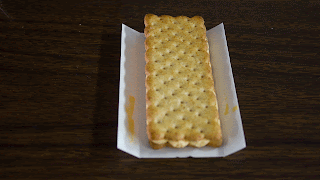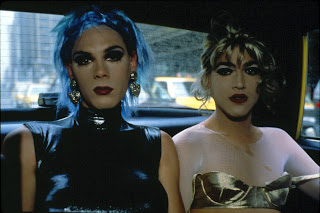Artist Analysis #1
Shana ParkeHarrison "Summer Arm"
The photograph "Summer Arm" is from Shana and Robert ParkeHarrison's 2007 set "Counterpoint". It is an image of an outstretched arm held up by mechanical pieces. The arm appears to have plants sprouting from it, with butterflies, blurred in motion, enjoying the flowers. The subject is photographed on a white background, which accentuates both the bright colors of the organic matter, and the high contrast of the metallic elements. The arm and machinery occupy the lower third of the image, while the plant life takes up the middle, and the top third is mostly empty, with the exception of a butterfly. This composition seems to lend itself to the theme of the entire set ("Counterpoint") about the intersection between humans, nature, and technology. The machinery element is bleak and colorless, while the natural elements are brightly colored and almost etherial.
In an artist's statement on their website (www.parkeharrison.com), the photographers discuss the intent of their imagery, saying that "These works feature an ambiguous narrative that offers insight into the dilemma posed by science and technology's failed promise to fix our problems…". This work in particular ("Summer Arm") illustrates this point with the stark contrast between nature and technology by dividing the frame with each element.
Artist Analysis #2
Sandy Skoglund "The Cocktail Party"

"The Cocktail Party" a sculptural installation accompanied by a photograph with the same thematic elements. The photograph was taken in 1992, then an installment was built to replicate the image in 2011. Skoglund's work often deals with surreal metaphors to describe social situations and the discomfort they cause her. Several of her other works involve large set construction and sculptural elements. The photograph is almost entirely monochromatic, with the exception of a few models' heads/legs emerging from costumes made entirely of "cheese doodles". The entirety of the set is covered with the dusty orange snack food. There are several mannequins that adorn the set that are covered in cheese doodles as well. The use of light, shadow, and depth of field, however, keep the photograph from appearing flat (in spite of being monochromatic). With the combination of deep focus and high key lighting, the subjects of the photo (the party guests) pop off the background, giving the illusion of a real party in motion.
The piece is meant to be a statement on Skoglund's social anxieties. She used cheese doodles as the medium because they are known to leave behind a sticky residue when handled. Perhaps this is how the artist feels about the after-effects of a party setting? It also seems to be a statement on the tacky nature of most cocktail parties (in the artist's view) as cheese doodles are a cheap and unhealthy snack food. What I found most interesting about this photograph is the choice of costumes for the models/mannequins. They are all dressed as if they are at a 1950's style cocktail party (complete with a Donna Reed hairstyle on the mannequin in the foreground). I feel that, as this image was created in 1992, this choice could further reflect Skoglund's feelings on cocktail parties: they are outdated, useless social exercises, carried out by the least progressive in our culture (or, those stunted…trapped in the 1950's). I like both the eye-catching quality of this VERY orange image, as well as the social norms it scrutinizes.
Artist Analysis #3
Sam Taylor Wood "Escape Artist"
The color photograph "Escape Artist" depicts a woman being lifted into the air at the waist by a bundle of balloons. The woman (who is Sam Taylor Wood acting as her own model) is bent in half where the balloons are tied to her, her hands and feet dangling several inches from the ground. The subject is lit from above with a spot light, while the background is in complete darkness. Aside from the balloons which are very colorful, the photograph consists of a very muted color scheme (beige, brown and white). The photograph is framed vertically to catch the ascent of the "escape artist" from her disconnect shadow, to the top of the balloons.
Wood created this piece in response to her battle with both colon and breast cancer. In an interview with London Evening Standard, Wood revealed that she suffered several bruises and rope burns during the creation of this piece. She felt it necessary to hide her face in this shot because, not only was she showing pain in her face, but she wanted the picture to be about overcoming pain/strife, so she felt it was not important to see her face in the photo. Unlike her set "Suspended" that depict women gracefully suspended high about the floor in fluid, dance-like poses, the body shapes in "Escape Artist" are all clumsy, and seemingly out of the control of the models. This seems to speak directly to Wood's intent with the set, as she made it in response to her battle with cancer. I feel that "Escape Artist" is an incredibly strong work because it depicts the struggle that serious illness poses, along with the feeling of being helplessly dragged along in the hopes of salvation.
Artist Analysis #4
Stephen Shores "Uncommon Places"
I was unable to find the name of this specific photograph, but it is from Shores set "Uncommon Places". It features a snapshot-like picture of a breakfast served at a diner. On the table, there is a plate of pancakes, a cantaloupe, glasses of milk and water, and paper palcemats depict Native American themed cartoons. This photograph consists of many strong graphic elements, as many objects on the table are round (the pancakes, the glasses, the half melon, the salt shaker…) but there are also several line elements (the silverware, the wood grain of the table, the square place mats). There are pops of color throughout the photo, but just like the many diner dishes it represents, the overall color scheme of the photograph is varying shades of brown.
This photograph was appealing to me because it is a very familiar image. Though it is Shores specific encounter with a specific diner, it is taken from the perspective of someone sitting down to eat a sad diner breakfast. No attempts seem to have been made to tart up the food in the same way food photographers do. The butter on the pancakes has melted, leaving a mushy dark hole in the center of the photographer's breakfast (delicious!). This realistic approach give the photograph a relatable quality, as if it could be a snapshot from anyone's road trip. The photograph offers a nostalgic and comforting feeling by simply being simple.


























